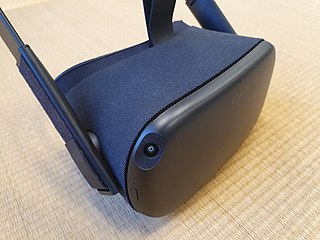
Virtual reality (VR) is a simulated experience that employs pose tracking and 3D near-eye displays to give the user an immersive feel of a virtual world. Applications of virtual reality include entertainment, education and business. Other distinct types of VR-style technology include augmented reality and mixed reality, sometimes referred to as extended reality or XR, although definitions are currently changing due to the nascence of the industry.

Michael Abrash is an American programmer and technical writer. He is best known for his magazine articles and books on code optimization and graphics for IBM PC compatibles and for working at id Software in the mid-1990s on the rendering technology for Quake. Since 2014, he has been the chief scientist of Oculus VR, a subsidiary of Meta Platforms.

Oculus Rift is a discontinued line of virtual reality headsets developed and manufactured by Oculus VR, a virtual reality company founded by Palmer Luckey that is widely credited with reviving the virtual reality industry. It was the first virtual reality headset to provide a realistic experience at an accessible price, utilizing novel technology to increase quality and reduce cost by orders of magnitude compared to earlier systems. The first headset in the line was the Oculus Rift DK1, released on March 28, 2013. The last was the Oculus Rift S, discontinued in April 2021.

Sketchfab is a 3D modeling platform website to publish, share, discover, buy and sell 3D, VR and AR content. It provides a viewer based on the WebGL and WebXR technologies that allows users to display 3D models on the web, to be viewed on any mobile browser, desktop browser or Virtual Reality headset.

Reality Labs, originally Oculus VR, is a business and research unit of Meta Platforms that produces virtual reality (VR) and augmented reality (AR) hardware and software, including virtual reality headsets such as Quest, and online platforms such as Horizon Worlds. In June 2022, several artificial intelligence (AI) initiatives that were previously a part of Meta AI were transitioned to Reality Labs. This also includes Meta's fundamental AI Research laboratory FAIR which is now part of the Reality Labs - Research (RLR) division.

The Samsung Gear VR is a virtual reality headset developed by Samsung Electronics, in collaboration with Oculus VR, and manufactured by Samsung. The headset was released on August 21, 2015.

HTC Vive is a line of virtual and mixed reality headsets produced by HTC Corporation. The brand currently encompasses headsets designed for use with personal computers as well as standalone headsets such as the Vive Focus line, Vive Flow glasses, and the Vive Elite XR mixed reality headset.

A virtual reality headset is a head-mounted device that provides a virtual reality environment for the wearer. VR headsets are widely used with VR video games but they are also used in other applications, including simulators and trainers. VR headsets typically include a stereoscopic display, stereo sound, and sensors like accelerometers and gyroscopes for tracking the pose of the user's head to match the orientation of the virtual camera with the user's eye positions in the real world.

AltspaceVR was a social VR platform that was founded in 2013 by Eric Romo and launched its initial product in May 2015. In 2017 it was acquired by Microsoft and became part of the Mixed Reality division within the Cloud and AI group. Some elements of the platform appear in Microsoft Mesh.

Daydream is a discontinued virtual reality (VR) platform which was developed by Google, primarily for use with a headset into which a smartphone is inserted. It is available for select phones running the Android mobile operating system that meet the platform's software and hardware requirements. Daydream was announced at the Google I/O developer conference in May 2016, and the first headset, the Daydream View, was released on November 10, 2016. To use the platform, users place their phone into the back of a headset, run Daydream-compatible mobile apps, and view content through the viewer's lenses.
Foveated rendering is a rendering technique which uses an eye tracker integrated with a virtual reality headset to reduce the rendering workload by greatly reducing the image quality in the peripheral vision.
OpenXR is an open-source, royalty-free standard for access to virtual reality and augmented reality platforms and devices. It is developed by a working group managed by the Khronos Group consortium. OpenXR was announced by the Khronos Group on February 27, 2017, during GDC 2017. A provisional version of the standard was released on March 18, 2019, to enable developers and implementers to provide feedback on it. On July 29, 2019, OpenXR 1.0 was released to the public by Khronos Group at SIGGRAPH 2019.

A virtual reality game or VR games is a video game played on virtual reality (VR) hardware. Most VR games are based on player immersion, typically through head-mounted display unit or headset with stereoscopic displays and one or more controllers.

The Oculus Go is a standalone virtual reality headset developed by Meta Reality Labs in partnership with Qualcomm and Xiaomi. It is in the first generation of Facebook Technologies' virtual reality headsets, and the company's first device in the category of standalone VR headsets, which was a new category at the time of the Go's release. The Oculus Go was unveiled on October 11, 2017 during the Oculus Connect developer conference, and released on May 1, 2018. Xiaomi launched their own version of the headset in China as the Mi VR Standalone on May 31, 2018.

The first-generation Oculus Quest is a discontinued virtual reality headset developed by Oculus, a brand of Facebook Inc., and released on May 21, 2019. Similar to its predecessor, Oculus Go, it is a standalone device, that can run games and software wirelessly under an Android-based operating system. It supports positional tracking with six degrees of freedom, using internal sensors and an array of cameras in the front of the headset rather than external sensors. The cameras are also used as part of the safety feature "Passthrough", which shows a view from the cameras when the user exits their designated boundary area. A later software update added "Oculus Link", a feature that allows the Quest to be connected to a computer via USB, enabling use with Oculus Rift-compatible software and games.

Oculus Rift S is a discontinued virtual reality headset co-developed by Lenovo Technologies and Oculus VR. Announced in March 2019 and released that May, it is a successor to the original Oculus Rift CV1 model, with noted changes including a new "inside-out" positional tracking system with cameras embedded inside the headset unit, a higher-resolution display, and a new "halo" head strap.

Oculus Rift CV1, also known simply as Oculus Rift, is a virtual reality headset developed by Oculus VR, a subsidiary of Meta Platforms, known at the time as Facebook Inc. It was announced in January 2016, and released in March the same year. The device constituted the first commercial release in the Oculus Rift lineup.

Aperture Hand Lab is a virtual reality (VR) game developed by Canadian studio Cloudhead Games and published by Valve, released for Windows on June 25, 2019. It is a tech demo that showcases the functions of the hand, knuckle, and finger tracking technology used by the Valve Index VR headset. The HTC Vive headset is also supported. The game is set in the Portal universe.

The Quest 2 is a virtual reality (VR) headset developed by Reality Labs, a division of Meta Platforms. It was unveiled on September 16, 2020, and released on October 13 as the Oculus Quest 2. It was then rebranded as the Meta Quest 2 in 2022, as part of a company-wide phase-out of the Oculus brand following the rebranding of Facebook, Inc. as Meta.














